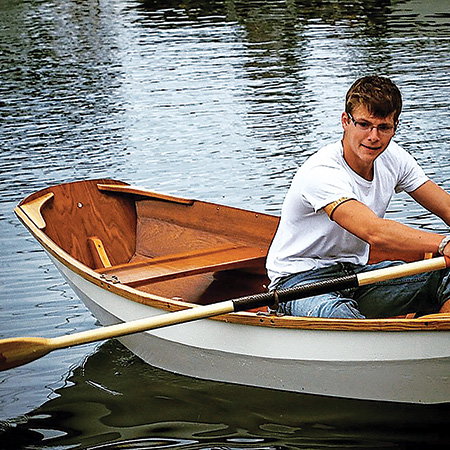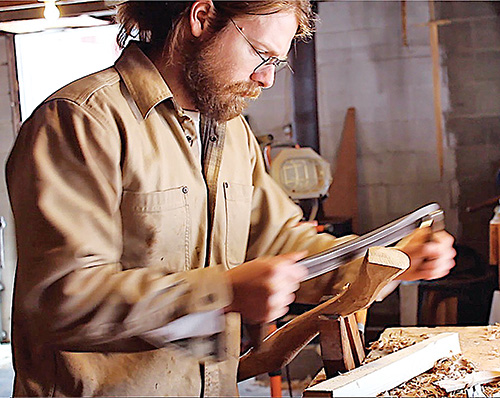
The summer my husband John Enger turned 16, he was moping near the Bayfield, Wisconsin, marina where his parents kept a sailboat. He had spent the previous few weeks attempting — and ultimately failing — to land his first “real” summer job. His miserable mood lead him downtown to the candy store, where he chanced on something that cured his angst even better than chocolate: a hand built nutshell pram. It was a romantic mahogany rowboat, à la classic Disney movie scenes. The kind of boat that gives a man a forearm workout as he sits in the wide end, while the girl he’s wooing admires him from her perch in the narrow point.
John, a hobby woodworker throughout his childhood, was drawn to its elegant beauty. But then he saw the “For Sale” price listed next to the boat and admired it for a whole different reason.
You’d think a handcrafted boat covered in dust, stuffed animals, would be a warning sign about the state of the boat-building economy. John recognized the name of the craftsman, a master boatbuilder. But in typical teenage form, his only thought was, “I could do this way better.”
He sank all his savings into the plans and building materials. Then he got to work.
John worked long days, teaching himself new techniques — all before the days of YouTube. Of course there were mistakes. Kind of a lot of them, he now admits.

At first, John shaped the mahogany strakes quickly with a new block plane. Over time, the tool got harder to use. Instead of shaving delicate curls, large chunks ripped from the wood. It was the same with the chisels. John figured he just had dumpy tools.
He never sharpened any of his tools during the entire project. Not once. Nowadays, in his work both as a woodworker and timber framer, he touches up his cutting edges every 20 minutes. Taking care of one’s tools is what actual woodworkers do. At least he learned that lesson from the experience.
The nutshell pram was also his introduction to mixing epoxy. Within a minute of adding too much hardener, John heard something that sounded like Pop Rocks®, followed by boiling steam wafting from the container in his hand. Strong fumes filled the barn. For a minute, he felt really good. Then unsteady. Then violently ill.
Pressing On

Despite the many setbacks, he pressed on, and by the end of the summer, the boat was done. John tried it out in the Bayfield marina. It was a joy to row. He figured he’d take a couple good photos and post fliers around town, offering it for sale. Instead, his dad bought it.
John’s dad had become fond of the boat and was loathe to see it go. Or so he says. I’ve always suspected there were other reasons. Maybe John’s dad better understood the realities of selling an expensive boat with only fliers, in a town where a professional had already failed to sell the same boat. Maybe he doubted that sailors would pay a couple grand for a vital watercraft item built by a teenager who didn’t even know how to properly sharpen his tools.

Regardless, John made some cash and for a few days felt very big. Then he made the mistake of calculating his time and materials and realized he had only made $2.50 per hour.
By all practical accounts, boat building wasn’t a good summer job.

But a few years later, John took a dubious girlfriend on a long row in that boat. She perched in the front while John got a Disney prince forearm workout. It was on that day, during a magnificent sunset, that I finally worked up the courage to say “I love you,” even though he’d been saying the L-word to me for months already. (It’s impossible to avoid falling in love on Lake Superior. I dare you to try.) And because John is a real miser, the money from that boat sat untouched in his savings for years. Until he worked up the courage to spend it … on the engagement ring now attached to my wedding band.
Maybe that little pram was worth the trouble after all.






